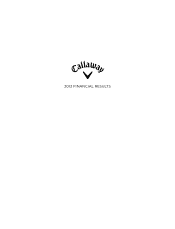Callaway 2013 Annual Report Download - page 19
Download and view the complete annual report
Please find page 19 of the 2013 Callaway annual report below. You can navigate through the pages in the report by either clicking on the pages listed below, or by using the keyword search tool below to find specific information within the annual report.5
are Acushnet (Titleist brand), Ping and TaylorMade. These competitors compete for market share in the golf clubs business,
with TaylorMade having a significant market share of the golf clubs business in the United States. The Company believes
that it is a technological leader in every golf club market in which it competes.
The golf ball business is also highly competitive. There are a number of well-established and well-financed
competitors, including Acushnet (Titleist and Pinnacle brands), SRI Sports Limited (Dunlop and Srixon brands),
Bridgestone (Bridgestone and Precept brands), Nike, TaylorMade and others. These competitors compete for market share
in the golf ball business, with Acushnet having a market share of over 50% of the golf ball business in the United States
and a leading position in certain other regions outside the United States. The Company believes that it is a technological
leader in the golf ball market.
For both golf clubs and golf balls, the Company generally competes on the basis of technology, quality, performance,
customer service and price. In order to gauge the effectiveness of the Company’s response to such factors, management
receives and evaluates Company-generated market trends for U.S. and foreign markets, as well as periodic public and
customized market research for the U.S. and U.K. markets from Golf Datatech that include trends from certain on- and
off-course retailers. In addition, the Company utilizes Sports Marketing Surveys for the U.K. markets and GfK Group
for the markets in Japan.
For risks relating to competition, see “Risk Factors” contained in Item 1A.
Seasonality of Company's Business
In most of the regions where the Company does business, the game of golf is played primarily on a seasonal basis.
Weather conditions in most parts of the world generally restrict golf from being played year-round, with many of the
Company’s on-course customers closing during the cold weather months. The Company’s business is therefore subject
to seasonal fluctuations. In general, during the first quarter, the Company begins selling its products into the golf retail
channel for the new golf season. This initial sell-in generally continues into the second quarter. The Company’s second
quarter sales are significantly affected by the amount of reorder business of the products sold during the first quarter. The
Company’s third quarter sales are generally dependent on reorder business but are generally less than the second quarter
as many retailers begin decreasing their inventory levels in anticipation of the end of the golf season. The Company’s
fourth quarter sales are generally less than the other quarters due to the end of the golf season in many of the Company’s
key markets. However, third quarter sales can be affected by a mid-year launch of product, and fourth quarter sales can
be affected from time to time by the early launch of product introductions related to the new golf season of the subsequent
year. This seasonality, and therefore quarter to quarter fluctuations, can be affected by many factors, including the timing
of new product introductions as well as weather conditions. In general, however, because of this seasonality, a majority
of the Company’s sales and most, if not all, of its profitability generally occurs during the first half of the year.
Environmental Matters
The Company’s operations are subject to federal, state and local environmental laws and regulations that impose
limitations on the discharge of pollutants into the environment and establish standards for the handling, generation,
emission, release, discharge, treatment, storage and disposal of certain materials, substances and wastes and the
remediation of environmental contaminants (“Environmental Laws”). In the ordinary course of its manufacturing
processes, the Company uses paints, chemical solvents and other materials, and generates waste by-products that are
subject to these Environmental Laws. In addition, in connection with the Top-Flite asset acquisition in 2003, the Company
assumed certain monitoring and remediation obligations at its manufacturing facility in Chicopee, Massachusetts. In
February 2013, the Company sold this facility and, as part of the terms of sale, the Company assumed certain ongoing
environmental remediation obligations.
The Company adheres to all applicable Environmental Laws and takes action as necessary to comply with these
laws. The Company maintains an environmental and safety program and employs full-time environmental, health and
safety professionals at its facilities located in Carlsbad, California, Chicopee, Massachusetts and Monterrey, Mexico. The
environmental and safety program includes obtaining environmental permits as required, capturing and appropriately
disposing of any waste by-products, tracking hazardous waste generation and disposal, air emissions, safety situations,
material safety data sheet management, storm water management and recycling, and auditing and reporting on its
compliance.
























